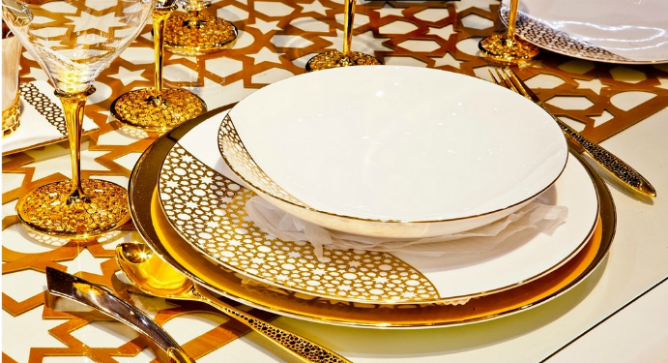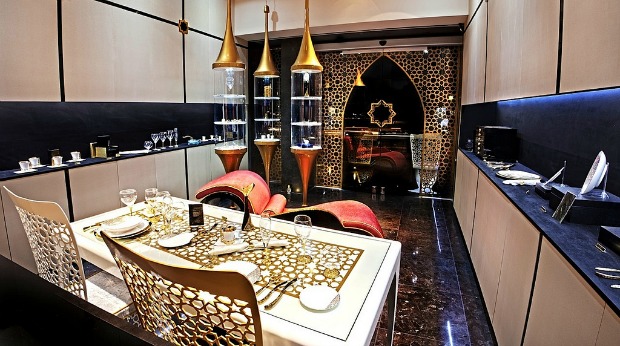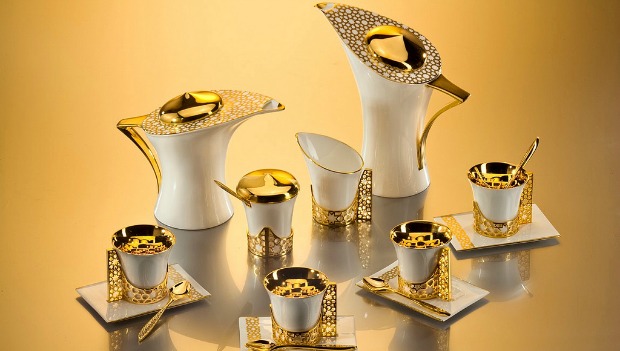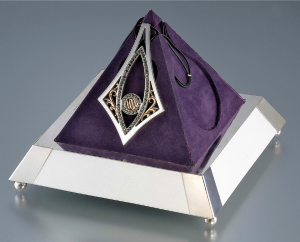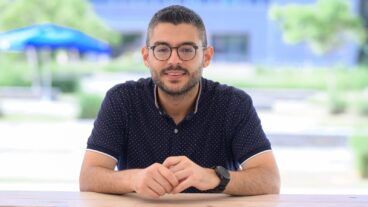The $10,000 silver necklace that Doron Merdinger created for Madonna is ringed with 72 small black diamonds, each etched with one of the three-letter mystical names of God. In the middle is her adopted Hebrew name, Esther.
Merdinger did not give this magnificent piece directly to the pop star, who sat next to him at a kabalistic gathering in Israel in 2004. “I was too shy,” admits the father of three and innovator of cutting-edge methodologies for turning precious materials into heirloom table settings and gift items, jewelry and furniture.
He gave the necklace to one of his assistants, who gave it to one of Madonna’s assistants, and he trusts she received it. She never contacted Merdinger, whose name likely meant little to her at the time.
Spread the Word
• Email this article to friends or colleagues
• Share this article on Facebook or Twitter
• Write about and link to this article on your blog
• Local relevancy? Send this article to your local press
But the Israeli designer’s reputation is spreading fast, even in unlikely places such as Abu Dhabi, where his pricey tableware gleams at the lavish Emirates Palace Hotel.
Though he’s had a Swiss retail presence for a few years and also sells his pieces at Thomas Goode in London, his newest venture is a storefront on Tel Aviv’s Kikar Hamedina (State Square) – the address of such upscale shops as Louis Vuitton and Gucci. He envisions Doron Merdinger concept stores in every major city’s prime street – Manhattan’s Madison Avenue, Moscow’s Petrovsky Boulevard, London’s Bond Street.
And yet this modest purveyor of luxury items considers himself a humble channel rather than an innovator.
Merdinger explains that he founded his business on insights gleaned from kabala — Jewish mysticism — and advanced sciences such as quantum theory and game theory. “I tried to learn as much as I could about the universe, seeing the parallels between spiritual and physical approaches,” he tells ISRAEL21c.
In 2005 he learned about computer-assisted design (CAD) software, which made it possible to create an entire three-dimensional collection based on the two-dimensional geometry of the arabesque shape — a classic Islamic decoration based on rhythmic linear patterns.
“I made huge discoveries about how the world was created, and I was able to connect it to mathematical approaches,” says Merdinger. That was the key to capturing the ancient arabesque form in the binary language of computers.
How nature behaves
His initial gold sculpture, “Fallen Leaf,” forms the core of the Arabesque Collection.
“I felt with this arabesque grid I was able to explain to the computer how nature behaves. Then I took it forward to introduce the world’s first fully integrated tableware collection using these 3D files for production, and very advanced technologies such as laser cutting.”
Turning the customary creative process on its head, Merdinger created tools to make a precision virtual image and only then played with colors and materials including gold, porcelain, crystal and wood.
“I am very confident that the material doesn’t matter,” he says. “I have had the merit that I have always been able to create everything I saw in my head. My creations are a symbol of the higher world since their morphology is unique — they were created in the virtual reality, the higher world.”
He sees his work as no less than a calling. “I’m merely the one who found [this technique], so I had to be very loyal to the origins of it.”
Born with a silver spoon
His own origins go back 44 years. Merdinger is one of the children of the founder of the well-known Israeli silversmith chain, Hazorfim. He was only 16 when his dad passed away.
“When I was younger, I was home a lot because of my asthma, and my room was like a lab. I had a computer – one of the first in Israel – and I used to win a lot of contests for drawing, sculpturing and LEGO. My father would come home to find the crystal chandelier getting smaller and smaller all the time because I would use the Swarovski pieces to create all sorts of stuff.”
In high school, he studied microelectronics and computers, and during his military service in an air force intelligence unit, he dealt in 3D imaging.
With the encouragement of his mother and older brother, he earned a degree in business administration at New York University. After six years he became general manager of Hazorfim, transitioning it from a Judaica business into a worldwide giftware company.
“I redefined the core goal and set very high standards and directions, and then started introducing new items,” he says. “To materialize my own dreams and pursue my own goals I then decided to leave the company, during the same week the oldest of my three boys was born.”
Star of Abraham
While still at Hazorfim, Merdinger had begun studying kabala and was eager to read Sefer Yetzira (Book of Creation), the earliest extant book of Jewish mysticism. Ascribed to the patriarch Abraham, it describes how God employed “32 wondrous ways of wisdom” to create the world, and delves into deeply esoteric topics.
“I couldn’t find a copy anywhere, and then one day it was waiting for me at the entrance to my studio in Jaffa,” Merdinger relates. That studio, part of an ancient building, had an eight-pointed Star of Abraham design embedded in the floor.
He adopted the star as his logo because he loves how its shape evokes the divine chariot by way of its two pyramids, one pointing up and one pointing down; as well as the four elements of water, earth, wind and fire.
Though he was schooled in silver, he chose gold as his primary material.
“Silver and gold are both noble metals, so the shift wasn’t dramatic,” he explains. “Silver is a mirror while gold is more dominant, has more luster and doesn’t get a patina. There is something very spiritual for me about gold.”
The most inexpensive item in the store is a credit-card holder he made for Centurian American Express (about NIS 350). Merdinger’s coffee set sells for about $50,000; his dinnerware set for about $250,000. Some of his pieces are manufactured in Israel and some elsewhere, but the designs always start on his laptop.
The hardest task, he says, is amalgamating different materials — porcelain with gold, glass with wood. “It is the same as in life – it’s very hard to make a unifying connection between man and woman. So the real secret is about combining and connecting materials, and this is where I found my passion.”




